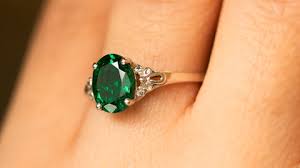Introduction:
Antique Rings hold a certain allure, capturing the essence of bygone eras with their intricate designs and rich histories. These timeless pieces serve as more than mere adornments; they are portals to the past, each carrying its own unique story. From Victorian romanticism to Art Deco opulence, antique rings offer a glimpse into the craftsmanship and sentiments of generations past.
1. The Charms of Victorian Era Rings:
During the Victorian era (1837-1901), sentimentality and symbolism heavily influenced jewelry design. Victorian rings often featured intricate details such as floral motifs, acrostic gemstone arrangements, and intricate filigree work. Engagement rings from this period often showcased clusters of diamonds or colored gemstones, symbolizing love, fidelity, and eternity. Additionally, mourning rings, adorned with black enamel and hairwork, reflected the era’s preoccupation with mortality and remembrance.
2. Art Nouveau’s Whimsical Beauty:
Emerging at the turn of the 20th century, the Art Nouveau movement ushered in a new era of artistic expression in jewelry design. Inspired by nature’s organic forms, Art Nouveau rings often featured flowing lines, delicate enamel work, and motifs of flowers, insects, and mythical creatures. These rings were characterized by their asymmetry and emphasis on craftsmanship, with designers like René Lalique and Georges Fouquet leading the way in creating exquisite pieces that celebrated beauty in its most whimsical forms.
3. The Glamour of Art Deco Rings:
The Art Deco period, spanning the 1920s and 1930s, epitomized the opulence and modernity of the Jazz Age. Art Deco rings were characterized by geometric shapes, bold colors, and the innovative use of materials such as platinum, diamonds, and vibrant gemstones like emeralds, rubies, and sapphires. These rings exuded a sense of luxury and sophistication, reflecting the era’s fascination with glamour and excess. Engagement rings from this period often featured striking geometric settings and intricate diamond pavé work, symbolizing the prosperity and optimism of the Roaring Twenties.
4. Retro Glamour and Hollywood Influence:
The Retro period, which followed the austerity of World War II, brought a return to luxury and glamour in jewelry design. Influenced by Hollywood’s golden age and the rise of celebrity culture, Retro rings featured bold, sculptural designs and oversized gemstones. Yellow and rose gold were popular choices during this era, complemented by bold accents such as ribbons, bows, and floral motifs. Cocktail rings became a staple of Retro style, adorned with large, colorful gemstones that made a statement on the red carpet and beyond.
5. Collecting Antique Rings: A Passion and a Legacy:
For collectors and enthusiasts, antique rings hold a special allure that goes beyond their aesthetic appeal. Each ring tells a story, carrying with it the memories and emotions of its previous owners. Collecting antique rings is not just a hobby; it’s a journey through history, culture, and craftsmanship. Whether passed down through generations or discovered in antique shops and auctions, these rings connect us to the past and serve as tangible reminders of our shared human experience.
Conclusion:
Antique rings are more than just beautiful pieces of jewelry; they are windows into the past, capturing the spirit of their respective eras and the sentiments of those who wore them. From the romanticism




